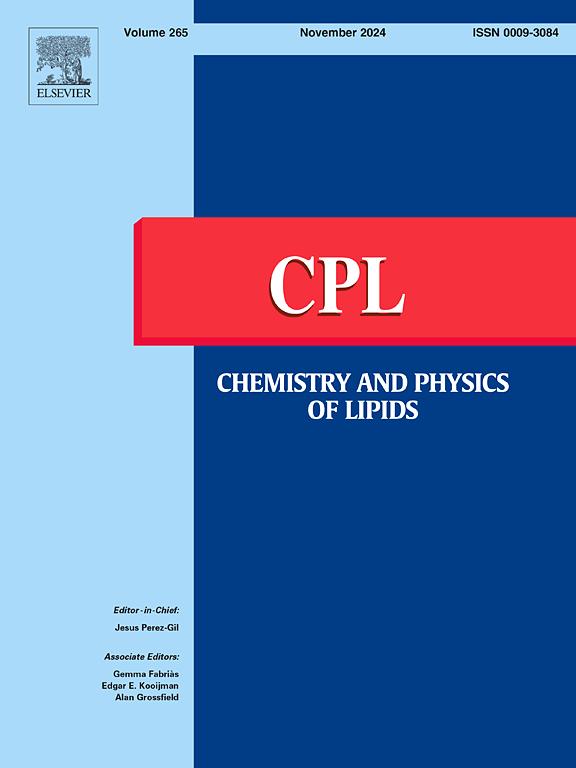Detergent-resistant membranes in HeLa cells. A comparative study with an electrochemical and lipidomic perspective
IF 2.8
3区 生物学
Q2 BIOCHEMISTRY & MOLECULAR BIOLOGY
引用次数: 0
Abstract
Two procedures are compared for the isolation of detergent-resistant membranes (DRMs) from the HeLa model cell line. The isolation was based on application of Triton X-100 followed by 4 or 18 h ultracentrifugation in sucrose (5–42.5, % w) or Optiprep™ (10–25, % w) gradients. In the fractions obtained, the total amount of protein, cholesterol, and free thiols was evaluated using spectrophotometry. Increased protein as well as free thiol contents were demonstrated in higher density fractions. In contrast, the highest cholesterol levels were observed in light or medium heavy fractions with a low proportion of sucrose or Optiprep, especially after 18 h of centrifugation. For the sucrose gradient, we used voltammetric determination of the catalytic hydrogen evolution reaction at the Hg-electrode for individual fractions. The catalytic response, expressed as the height of the presodium wave, increased from light to heavy fractions corresponding to the protein content and/or other catalytically active species. The size of the DRMs or their associates ranged from 20 to 1000 nm, independently of the isolation protocol used. Proteins typically associated with DRMs such as caveolin and flotillin and characteristic for light and medium heavy gradient fractions, were determined using immunochemistry. We studied the subcellular localization of caveolin, flotillin, raftlin and transferrin, a control protein found intracellularly in the cytoplasm. Using confocal fluorescence microscopy, we confirmed the presence of caveolin and flotillin in the cytoplasmic membrane of HeLa cells. Raftlin was identified in both the membrane, and as part of the cell nucleus. We also performed untargeted lipidomic LC-MS analysis of the individual fractions of sucrose ultracentrifugation gradient obtained after 18 h. The predominant lipid subclasses were phosphatidylcholines and diacylglycerols. Apart from cholesterol and its ester, the rest of identified lipid classes was similar to that found in full HeLa cell lysates. The presented findings could be important for interpreting interlaboratory results and may be used as a guide for further studies on DRMs.
HeLa细胞中的抗洗涤剂膜。电化学与脂质组学的比较研究。
比较了从HeLa模型细胞系中分离耐洗涤剂膜(DRMs)的两种方法。应用Triton X-100进行分离,然后在蔗糖(5-42.5,% w)或OptiprepTM (10-25, % w)梯度下进行4或18h的超离心。所得馏分中,用分光光度法测定蛋白质、胆固醇和游离硫醇的总量。密度越高,蛋白质和游离硫醇含量越高。相比之下,在低比例蔗糖或Optiprep的轻或中重馏分中观察到最高的胆固醇水平,特别是在离心18h后。对于蔗糖梯度,我们使用伏安法在氢电极上测定催化析氢反应。催化反应,表示为钠前波的高度,从轻馏分增加到重馏分,对应于蛋白质含量和/或其他催化活性物质。与所使用的隔离协议无关,drm或其关联物的尺寸范围为20至1000nm。通常与DRMs相关的蛋白质,如caveolin和flotillin,以及轻和中重梯度分数的特征,使用免疫化学测定。我们研究了小窝蛋白、浮蛋白、浮蛋白和转铁蛋白的亚细胞定位,转铁蛋白是胞内细胞质中的一种控制蛋白。利用共聚焦荧光显微镜,我们证实HeLa细胞的细胞质膜中存在小泡蛋白和浮蛋白。在细胞膜和细胞核中都发现了Raftlin。我们还对18h后获得的蔗糖超离心梯度的单个部分进行了非靶向脂质组学LC-MS分析。主要的脂类是磷脂胆碱和二酰基甘油。除了胆固醇及其酯外,其余鉴定的脂类与完整的HeLa细胞裂解物相似。所提出的研究结果可能对解释实验室间的结果很重要,并可作为进一步研究drm的指南。
本文章由计算机程序翻译,如有差异,请以英文原文为准。
求助全文
约1分钟内获得全文
求助全文
来源期刊

Chemistry and Physics of Lipids
生物-生化与分子生物学
CiteScore
7.60
自引率
2.90%
发文量
50
审稿时长
40 days
期刊介绍:
Chemistry and Physics of Lipids publishes research papers and review articles on chemical and physical aspects of lipids with primary emphasis on the relationship of these properties to biological functions and to biomedical applications.
Accordingly, the journal covers: advances in synthetic and analytical lipid methodology; mass-spectrometry of lipids; chemical and physical characterisation of isolated structures; thermodynamics, phase behaviour, topology and dynamics of lipid assemblies; physicochemical studies into lipid-lipid and lipid-protein interactions in lipoproteins and in natural and model membranes; movement of lipids within, across and between membranes; intracellular lipid transfer; structure-function relationships and the nature of lipid-derived second messengers; chemical, physical and functional alterations of lipids induced by free radicals; enzymatic and non-enzymatic mechanisms of lipid peroxidation in cells, tissues, biofluids; oxidative lipidomics; and the role of lipids in the regulation of membrane-dependent biological processes.
 求助内容:
求助内容: 应助结果提醒方式:
应助结果提醒方式:


